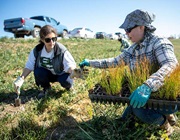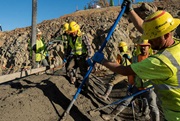Meeting the water needs of communities, economies, and the environment through regional investments and coordination, with state support.
Water is central to nearly everything we value in California. We must prepare our water systems for a warmer, more variable climate, while addressing long-standing challenges that include a lack of safe drinking water and unsustainable dependence on groundwater aquifers. With many partners across and outside of government, the Natural Resources Agency is working to enable regional water resilience so that communities are better able to withstand drought and flood and secure the water supplies that human and natural systems need to thrive.
Over the next 20 years, California could lose 10 percent of its water supplies. Our climate has changed, and the West continues to get hotter and drier. As it does, we will see on average less snowfall, more evaporation, and greater consumption of water by vegetation, soil, and the atmosphere itself. To thrive and grow as a state, we will have to make up for a loss of supply. On August 11, 2022, Governor Newsom released “California’s Water Supply Strategy: Adapting to a Hotter, Drier Future.” The strategy centers on actions to stretch existing water supplies and invest in new sources as climate change makes precipitation more erratic. The targeted actions sharpen focus on a set of actions in the Water Resilience Portfolio, California’s water policy blueprint. In October 2023, state agencies released a report that captures their progress implementing the Water Supply Strategy over the previous year.
In an April 2019 Executive Order, Governor Newsom recognized the need to take stock of California’s water resources and act to address more extreme droughts and floods, rising temperatures, overdrafted groundwater basins, aging infrastructure, and other challenges magnified by climate change. In fulfillment of that Executive Order, in July 2020, the Natural Resources Agency, California Environmental Protection Agency, and Department of Food and Agriculture together released a final Water Resilience Portfolio. The Portfolio includes a diverse set of actions to be taken by state agencies to empower local and regional entities to meet their unique challenges, while delivering on the state’s responsibility to provide tools and leadership, advance projects of statewide scale and importance, and help address challenges that are beyond the scope of any region.
Under the direction of Governor Gavin Newsom, California state agencies are advancing projects at the Salton Sea to improve air quality and provide critical environmental habitat for birds along the Pacific flyway. Flows into the Salton Sea have declined in recent years, and the result is a shrinking, increasingly saline lake. As the Sea recedes, previously submerged lakebed is being exposed, creating dust that can be hazardous as it dries and becomes airborne.
The California Natural Resources Agency, the California Department of Water Resources and the California Department of Fish and Wildlife are focused on implementing the Salton Sea Management Program, which includes a 10-year plan that aims to improve conditions by constructing 30,000 acres of habitat and dust suppression projects around the Sea.
Since early 2019, the State Team has significantly improved its capacity to deliver projects at the Sea. Informed by constructive input from community members, local leaders and interested groups, the team is working with partners to make substantial progress on the ground in 2020 to improve conditions for communities near the Sea. The state team also is working to improve transparency, engage community members in project planning and design, and incorporate local input in the SSMP project planning process.
Setting California on a path toward reliability, restoration and resilience in California Water.
The California Water Action Plan – issued at the direction of Governor Brown in January 2014 and updated in 2016 – set forth 10 priority actions that guide the state’s effort to create more resilient, reliable water systems and to restore critical ecosystems. In the nearly five years since the plan’s release, state agencies and their local, federal and tribal partners have made steady advances on all 10 priority actions.
NEW - Read the Water Action Plan Summary of Accomplishments 2014-2018 here.
Older documents:
Read the 2016 Water Action Plan Update here.
Read the January 2014 California Water Action Plan here.
Read the 2015 implementation report here.
Read the 2014 implementation report here.
Learn more about how the State of California is preparing for our water future:

Water Use and Quality Regulations

Local and Regional Water Projects

Restoring and Protecting Our Natural World



